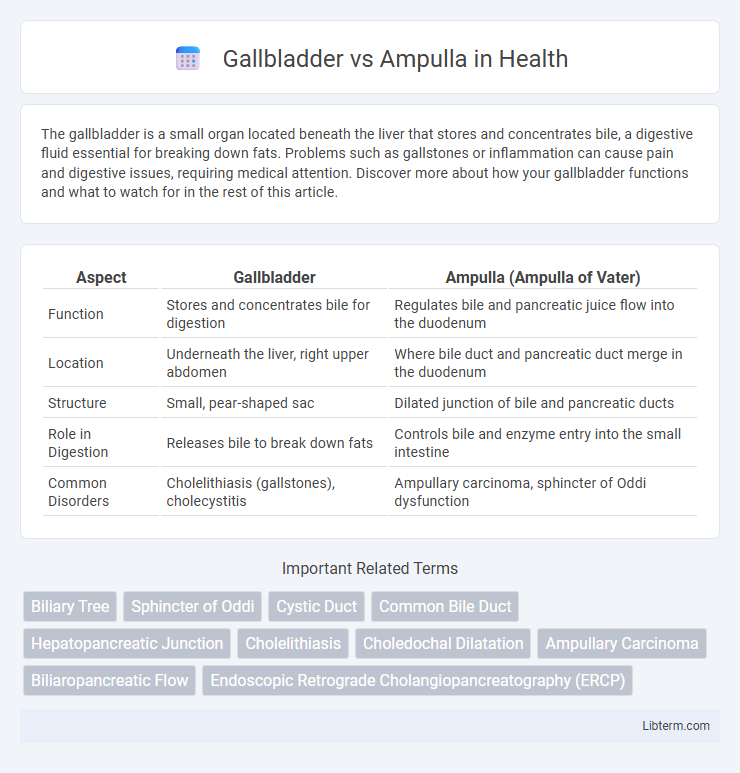The gallbladder is a small organ located beneath the liver that stores and concentrates bile, a digestive fluid essential for breaking down fats. Problems such as gallstones or inflammation can cause pain and digestive issues, requiring medical attention. Discover more about how your gallbladder functions and what to watch for in the rest of this article.
Table of Comparison
| Aspect | Gallbladder | Ampulla (Ampulla of Vater) |
|---|---|---|
| Function | Stores and concentrates bile for digestion | Regulates bile and pancreatic juice flow into the duodenum |
| Location | Underneath the liver, right upper abdomen | Where bile duct and pancreatic duct merge in the duodenum |
| Structure | Small, pear-shaped sac | Dilated junction of bile and pancreatic ducts |
| Role in Digestion | Releases bile to break down fats | Controls bile and enzyme entry into the small intestine |
| Common Disorders | Cholelithiasis (gallstones), cholecystitis | Ampullary carcinoma, sphincter of Oddi dysfunction |
Introduction to Gallbladder and Ampulla
The gallbladder is a small, pear-shaped organ located beneath the liver that stores and concentrates bile produced by the liver. The ampulla, also known as the ampulla of Vater, is a critical anatomical structure where the bile duct and pancreatic duct merge and empty into the duodenum. Both play essential roles in digestion, with the gallbladder regulating bile release and the ampulla controlling the flow of bile and pancreatic enzymes into the small intestine.
Anatomy of the Gallbladder
The gallbladder is a small, pear-shaped organ located beneath the liver, responsible for storing and concentrating bile produced by hepatocytes. It connects to the biliary tree via the cystic duct, which joins the common hepatic duct to form the common bile duct, passing through the ampulla of Vater before emptying into the duodenum. Unlike the ampulla, which is a dilated junction of the bile and pancreatic ducts, the gallbladder's anatomy includes the fundus, body, infundibulum, and neck, each facilitating bile storage and regulated release.
Anatomy of the Ampulla
The ampulla of Vater, also known as the hepatopancreatic ampulla, is a critical anatomical structure where the common bile duct and the main pancreatic duct converge before emptying into the duodenum at the major duodenal papilla. Unlike the gallbladder, which stores and concentrates bile, the ampulla functions as a regulated conduit controlling the flow of bile and pancreatic enzymes into the small intestine. Its smooth muscle sphincter, the sphincter of Oddi, plays a vital role in coordinating digestive secretions and preventing reflux, distinguishing its anatomy and function from the gallbladder's reservoir role.
Functions of the Gallbladder
The gallbladder functions primarily as a storage organ for bile produced by the liver, concentrating and releasing it into the small intestine to aid in the digestion of fats. By regulating bile flow, the gallbladder facilitates the emulsification and absorption of dietary lipids, enhancing nutrient uptake. Unlike the ampulla of Vater, which serves as a junction for bile and pancreatic enzyme secretion into the duodenum, the gallbladder's role centers exclusively on bile storage and controlled release.
Functions of the Ampulla
The ampulla of Vater regulates the flow of bile and pancreatic juice into the duodenum, playing a crucial role in digestion and nutrient absorption. It controls the release of enzymes essential for breaking down fats, proteins, and carbohydrates. The ampulla also prevents the backflow of duodenal contents, maintaining optimal conditions for digestive processes.
Differences in Location
The gallbladder is a small, pear-shaped organ located beneath the liver, serving as a storage site for bile. The ampulla, specifically the ampulla of Vater, is situated at the junction where the bile duct and pancreatic duct empty into the duodenum. Their distinct anatomical positions reflect their separate roles in bile storage and digestive enzyme delivery.
Distinct Physiological Roles
The gallbladder functions as a storage and concentration site for bile produced by the liver, releasing it during digestion to aid in fat emulsification. In contrast, the ampulla of Vater (hepatopancreatic ampulla) serves as the critical junction where bile and pancreatic enzymes converge and empty into the duodenum, regulating digestive secretions through the sphincter of Oddi. These distinct physiological roles highlight the gallbladder's role in bile management versus the ampulla's role in coordinating digestive enzyme delivery.
Common Disorders Affecting the Gallbladder
Common disorders affecting the gallbladder include cholelithiasis (gallstones), cholecystitis (inflammation of the gallbladder), and biliary dyskinesia, which impair bile storage and release. The ampulla of Vater, located where the common bile duct meets the pancreatic duct, can be affected by ampullary stenosis or tumors, but these conditions primarily impact bile flow into the duodenum rather than gallbladder function. Gallbladder disorders often present with right upper quadrant pain, nausea, and digestive disturbances due to bile accumulation and inflammation.
Common Disorders Affecting the Ampulla
The ampulla of Vater, where the common bile duct and pancreatic duct converge, is prone to disorders such as ampullary stenosis, ampullary carcinoma, and sphincter of Oddi dysfunction, which can cause bile and pancreatic juice flow obstruction. Gallstones commonly cause ampullary obstruction by lodging at the ampulla, leading to pancreatitis or cholangitis. Diagnosing ampullary disorders often involves endoscopic retrograde cholangiopancreatography (ERCP) and imaging techniques to evaluate the bile duct and pancreatic duct patency.
Diagnostic and Treatment Approaches
Gallbladder disorders are primarily diagnosed through ultrasound imaging, revealing gallstones or inflammation, while treatment often involves cholecystectomy or medication for symptom relief. Ampullary pathology diagnosis relies on endoscopic retrograde cholangiopancreatography (ERCP) or magnetic resonance cholangiopancreatography (MRCP) to detect obstructions or tumors, with treatment options ranging from endoscopic stenting to surgical resection. Both conditions require targeted imaging techniques to guide interventions that address obstruction, inflammation, or malignancy effectively.
Gallbladder Infographic

 libterm.com
libterm.com